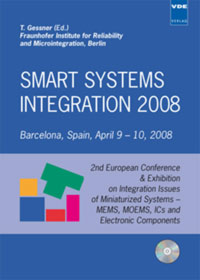Smart Power SoC: Technology Challenges and Innovations
Konferenz: Smart Systems Integration 2008 - 2nd European Conference & Exhibition on Integration Issues of Miniaturized Systems - MOMS, MOEMS, ICS and Electronic Components
09.04.2008 - 10.04.2008 in Barcelona, Spain
Tagungsband: Smart Systems Integration 2008
Seiten: 5Sprache: EnglischTyp: PDF
Persönliche VDE-Mitglieder erhalten auf diesen Artikel 10% Rabatt
Autoren:
Tack, Marnix; Moens, Peter; Gillon, Renaud (Technology Development, AMIS, Oudenaarde, Belgium)
Janssens, Johan (Automotive Product Development, AMIS, Vilvoorde, Belgium)
Inhalt:
Since many decades, the increasing demand for more on-chip computing power, higher speed and more memory has driven a continuous shrinking of CMOS technologies towards 65nm and 45nm dimensions, following Moore’s Law. In parallel a second trend, called “More-than-Moore”, is becoming increasingly important. These technologies are strongly Application-Driven and focus on the interface between the “real analog world” and powerful digital backbone systems. They aim for increasing integration of analog and hybrid functions, such as High Voltage interfaces, Power Switches, Bio-functions, Sensors (e.g. MEMS), and even Actuators. An important class of “More-than-Moore” technologies are the so-called Smart Power Technologies (SPT), driven by a variety of applications in strongly growing markets for telecom, automotive, industrial, and “smart home” actuator and sensor applications. This paper gives an overview of the main challenges and ongoing innovations for the next generation Smart Power Technologies. A key figure-of-merit of power drivers is the Ron (in Ohm*mm2) for a given breakdown voltage Vbd. Novel device concepts are presently under development to break through the so-called Si-limit. More specifically, we will present latest results on the XtreMOSTM technology, that is using vertical integration and superjunction-physics to reduce the Ron (and thus the area and cost) of powerdrivers by a factor 2-3. Another challenge in SPT’s is their Safe-Operating-Area (SOA), to allow for operation in harsh environments (e.g. automotive applications) with very demanding specifications on ESD, EMC, operating temperatures up to 200 degree C, and high quality requirements (‘0 ppm’). The, applicationdependent, different types of SOA (electrical-, e-thermal- and reliability-SOA) will be discussed both for state-of-the-art and for the above mentioned new driver technology. More specifically, new results of coupled electrothermal simulation (both static and dynamic) of drivers integrated in complex SOC will be presented. Finally some practical examples are given of the impact of the above mentioned developments in automotive Smart Power SoC.


